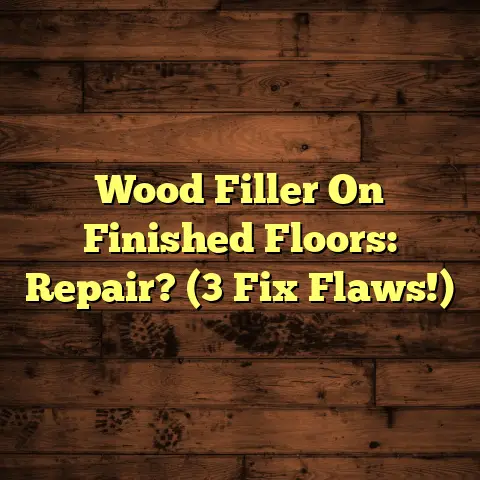Hardwood Over Concrete? (5 Subfloor Secrets!)
I’m excited to dive into a topic that’s near and dear to my heart: hardwood over concrete.
It’s a challenge, no doubt, but with the right knowledge, you can achieve stunning results.
Let’s explore the evolution of flooring, focusing on hardwood and how it’s become more versatile, especially over concrete.
Innovation has been key in tackling issues like moisture, insulation, and durability.
I’m going to share some “subfloor secrets” that will help you make smart decisions.
Section 1: Understanding the Concrete Subfloor
Definition and Characteristics of Concrete Subfloors
What exactly is a concrete subfloor?
It’s the base layer, often found in basements or ground-level homes, providing a solid foundation for your flooring.
Concrete is known for its strength, durability, and thermal mass (its ability to store heat).
Challenges of Installing Hardwood Over Concrete
Now, here’s the catch: concrete and hardwood aren’t always the best of friends.
Concrete can absorb moisture, which can wreak havoc on your hardwood.
Temperature fluctuations can also cause problems, leading to expansion and contraction.
Uneven surfaces are another common issue.
Importance of Proper Preparation
This is where the magic happens!
Proper preparation is absolutely crucial.
I always start by testing the moisture levels in the concrete.
You can use a concrete moisture meter for this.
The acceptable moisture level usually falls between 8% and 12%.
Ensuring a level surface is equally important.
Self-leveling compounds can be a lifesaver here, filling in any dips or cracks.
Section 2: The Role of Underlayment
What is Underlayment?
Think of underlayment as a cushion between your concrete and hardwood.
It provides a smooth surface, reduces noise, and adds a layer of protection against moisture.
Types of Underlayment
There’s a whole world of underlayment out there!
- Foam: Affordable and provides some cushioning.
- Cork: Natural, eco-friendly, and great for sound dampening.
- Rubber: Excellent moisture barrier and offers good impact resistance.
Each has its pros and cons, so consider your specific needs.
Moisture Barrier Functionality
This is non-negotiable!
A moisture barrier is essential for preventing moisture from seeping into your hardwood.
It’s like a raincoat for your floor.
Without it, you’re asking for trouble down the road.
Section 3: The Subfloor Secrets Revealed
Alright, let’s get to the good stuff!
Secret #1: Moisture Management
Moisture is the enemy!
Before installation, test, test, test!
Use a concrete moisture meter to get accurate readings.
A vapor barrier is your best friend.
I recommend a polyethylene sheet at least 6 mil thick.
Overlap the seams by at least 6 inches and tape them securely.
This creates a waterproof barrier that will protect your hardwood.
Secret #2: Insulation Considerations
Concrete can get cold, especially in basements.
Insulation can make a huge difference in floor temperature and overall comfort.
Consider using an underlayment with built-in insulation.
This not only warms up the floor but also improves energy efficiency.
According to the U.S.
Department of Energy,
proper insulation can save you up to 15% on
your heating and cooling bills.
Secret #3: Choosing the Right Hardwood
Not all hardwood is created equal!
Engineered hardwood is generally a better choice for concrete subfloors.
Why?
It’s more dimensionally stable than solid hardwood, meaning it’s less likely to warp or cup due to moisture.
Solid hardwood can be used, but it requires even more stringent moisture control measures.
Secret #4: Installation Techniques
There are three main ways to install hardwood over concrete:
Floating: The easiest and most common method.
The planks are connected to each other, creating a “floating” floor that isn’t attached to the concrete.Glue-Down: Provides a very stable and solid feel.
Requires a special adhesive designed for hardwood and concrete.Nail-Down: Not recommended for concrete unless you install a wooden subfloor first.
This adds extra cost and complexity.
Each technique has its advantages and disadvantages, so choose wisely.
Secret #5: Maintenance and Care
Once your beautiful hardwood floor is installed, the work isn’t over!
Regular cleaning is essential.
Use a hardwood floor cleaner and avoid excessive water.
Place mats at entryways to trap dirt and moisture.
Consider using a dehumidifier to control humidity levels, especially in basements.
I’ve seen so many floors ruined by neglect.
Don’t let that happen to yours!
Conclusion: Recap of the 5 Subfloor Secrets
Let’s recap those subfloor secrets:
- Moisture Management: Test, vapor barrier, seal!
- Insulation Considerations: Warm feet, happy life!
- Choosing the Right Hardwood: Engineered is your friend!
- Installation Techniques: Floating, glue-down, or nail-down?
- Maintenance and Care: Clean, protect, and love your floor!
Installing hardwood over concrete can be a challenging but rewarding project.
By understanding the unique challenges and solutions, you can create a stunning and durable floor that will last for years to come.
Don’t be afraid to embrace innovation and explore new flooring solutions.
With the right knowledge and preparation, you can achieve amazing results.
So, go out there and create the hardwood floor of your dreams!





